COGNITIVE DECLINE: THE IRREDUCIBLE
LEGACY OF OPEN BORDERS
Cognitive decline, the result of third world
immigration, differential fecundity and gene flow, will mark the end of Western ascendancy.
Described herein is the path to collapse and the improbable circumstances
surrounding its discovery.
Let martial note in triumph float
And liberty extend its mighty hand
A flag appears 'mid thunderous cheers,
The banner of the Western land.
--John Philip Sousa
Prodigy's Journal, December 14, 2004
I had seen little of Mentor lately and so grew eager as I neared his house. Crossing Oxford Street, my collar turned up
against the wind, I wondered why I had been summoned. No way could I have anticipated the events that would follow.
"Come in," said Mentor answering the bell.
He seemed less effusive than usual, imperceptibly more introspective. "Have some cookies," he said, adjusting quickly to
his guest. I sensed he was glad to see me.
"Thank you," said I, "M & Ms are my favorite."
"You may be curious why I asked you to here today, Prodigy."
"I confess I am, Mentor."
Mentor walked across the room. He sat down at the piano and began to sing while improvising an accompaniment.
Freude, schöner Götterfunken,
Tochter aus Elysium,
Wir betreten feuertrunken,
Himmlische, dein Heiligtum!
Mentor was multi-channeled, so it was not unusual for him to improvise at the piano during a conversation. In fact, now
and then he would read Physical Review Letters as well. I had become used to this ritual, and consequently did not look to
Schiller's verse for clues to why I was there. The reason was made clear soon enough. Suddenly Mentor stopped playing.
Turning about to face me, he put his fingertips together and leaned slightly forward.
"I have a woman friend whom I sometimes see."
"Oh?"
"Her son, Fifo, wrote me a letter. It concerns you."
"Me?"
Mentor walked to his desk and took from it a sheet of paper. "Here, read it yourself."
The salutation took me by surprise. I read on.
Dear Uncle,
A frequent visitor to my house, Uncle Wim, has acquainted me with some disturbing facts. (I should clarify that it is he, not
I, who is disturbed.) His concern is with third-world immigration to his native Netherlands, mostly by Surinamese,
Antilleans, Turks and Moroccans. They have, he claims, flooded the country, pushing crime, welfare dependency and
unemployment to new levels.
Uncle Wim has become a terrible bore, going on and on about how Muslims will ruin the country. I know that, in the long
haul, inflow of low-IQ peoples cannot help but depress the Dutch economy, so I referred him to Prodigy's smart fraction
theory for an explanation of how. Unfortunately, he does not seem to understand it. (Uncle Wim's intellect is not quite up
to his good looks.)
Mother tells me you actually know Prodigy. She has got the idea that I should be more like him. (You know how she is
always pushing me to excel.) She thinks a term paper on smart fraction theory and immigration would boost my class
standing. Unfortunately, I am a bit of an academic slouch, and lacking Prodigy's precocity I fear her ambitions for me will
never be realized. She asked Uncle Wim to help me, little knowing how absurd was that request. Still, I would very much
like to please her, as I know you would too. Do you think you might prevail upon Prodigy to help me? I would be forever
in your debt. Mother assures me, Uncle, that she too would be ever grateful.
Kindest regards,
Fifo
I toyed with making some goofy remark about Fifo's Dutch uncle, but repressed the temptation. It was plain that Mentor
was deadly serious. "I shall do what I can," I volunteered.
"Thank you," said Mentor, obviously relieved.
I could not imagine that Mentor would himself be unable to perform this little service for Fifo. Underneath Mentor's
forehead I imagined a gigantic brain struggling to compete with his unseen rival, Uncle Wim. Mentor's prodigious powers
were of little value in this arena. I was glad to help.
"Fifo is brighter than he admits," I offered. "He understands that a country's economic success is causally connected to the
intelligence of its people; that a nation of dimwits cannot compete with a nation of philosophers; and that between the
simpleton and the savant lies a distribution of intellect that differs among peoples. Fifo knows that immigration from the
third world will move the center of gravity of brainpower down the IQ spectrum, and in the long run, through influx,
fecundity and gene flow, will have a lasting effect.
"We do not want Fifo to get lost in the details of smart fraction
theory. Therefore, we should make some qualitative points. Fifo should
understand that the theory is based on the idea that a country's economic success is limited by the cognitive ability of its
workforce. Bookkeepers, credit clerks, lab techs, salesmen, secretaries, sales account executives, administrative assistants,
store managers etc. are the folks who, in a market economy, do the heavy lifting. They are not rocket scientists, but they do
fall on the right side of the bell curve. They form what I call a nation's 'smart fraction.' When their supply is exhausted,
economic growth shuts down. The fundamental assertion of smart fraction theory is that per capita GDP is proportional to
the size of a country's smart fraction, a proposition established empirically in The Smart Fraction Theory of IQ and the
Wealth of Nations and also in Smart Fraction Theory II: Why Asians Lag, where it was determined that a verbal IQ of
about 106 sets the lower bound of the smart fraction.
"Cognitive differences between groups are sometimes difficult to detect. In fact, in the ordinary exchanges of life, a full
standard deviation could easily go undetected. Suppose, as reported by Lynn and Vanhanen in IQ and the Wealth of
Nations, the mean IQ of Belgians is one standard deviation greater than that of Moroccans. If we randomly select one
Moroccan and one Belgian, the Moroccan will be the smarter in about one of four trials. Such
an inherent cognitive difference might well be overlooked in social settings where charm, appearance and social grace often control human
interaction. In the proper context, however, even small cognitive gaps will have profound effects. Because of the one SD
difference, less than 9 percent of Moroccans can do smart-fraction work, compared to 36 percent of Belgians. Viewed in
this way it is easy to understand the different living standards of the two peoples."
"I am eager for you to go on," interjected Mentor, "but let us eat before you continue. Are you hungry?"
"As you know I am always hungry, Mentor."
"Good, we shall dine on fare that has been known for five-hundred years. It is now a common indulgence, but was not
always so. Caterina dei Medici brought it to France in 1533."
"Wow!"
"More recently, it was served on a special occasion in a three-hundred year old palace on via Monte di Dio in Naples. The
palace, il Palazzo Serra di Cassano, was damaged in WWII and was sadly suffering from neglect when its
owner, il
Duca Serra di Cassano, decided to restore it to its original splendor. When the renovation was complete the duke
celebrated with one of the most elaborate banquets of modern times. After sweets, cheese and fruit, the meal concluded
with a serving of spaghetti aglio e olio. And that my boy is what we
shall have for lunch."
Mentor had created an air of epicurean expectancy. I could hardly wait. He brought forth from the pantry a large
cauldron. Filling it a third full with water, he set it on the stove to heat. Meanwhile, he peeled and sliced some garlic,
placing it in a skillet with a few spoons of olive oil and a dash of crushed red pepper. When the water came to a boil, he
threw in a bit of salt and added the spaghetti. "Here, Prodigy, chop this parsley." When the pasta was almost ready, he
turned up the flame on the skillet, heating the garlic, pepper and oil with stirring until the garlic took on the faintest golden
hue. "You must be very careful here," he interjected. "The smell of burnt garlic does not belong in the kitchen." Mentor
drained the spaghetti and transferred it with the parsley to the skillet. Over the heat, he tossed the mixture for a few seconds
before turning it into our plates
"Such a simple dish to cap a grand meal?" I wondered aloud.
"Indeed, Prodigy. Gastronomy like science is most beautiful when it is simple."
Mentor opened a bottle of '97 Gattinara. Pouring two glasses, he said: "Best not to mention this to Mom. She will not
understand."
Renewed by lunch, I again took up the application of smart fraction theory to immigration. "What can you tell me about the
IQs of third-world immigrants?" I asked.
Mentor rummaged through some papers on his desk. "I ran across this a few days ago," he said handing me a reprint of a
review of several Dutch studies. I read the abstract.
Jan te Nijenhuis and Henk van der Flier, "Group differences in mean intelligence for the Dutch and Third World
immigrants," Journal of Biosocial Science, 33 (2001), 469-475.
Evidence from eleven samples indicates that the mean IQ of third world immigrants in the Netherlands is lower than the
Dutch mean by approximately one standard deviation for Surinamese and Antilleans, and by approximately one and a half
standard deviations for Turks and Moroccans. Since IQ tests provide the best prediction of success in school and
organizations, it could be that the immigrants' lower mean IQ is an important factor in their low status on the Dutch labour
market. The IQs of second-generation immigrants are rising.
"The studies all find significant differences between ethnic Dutch and immigrant populations," Mentor explained.
"Children born in the Netherlands of Surinamese and Antillean immigrants have IQs about 0.8 standard deviations below native Dutch
children. Children born in the Netherlands of Turkish and Moroccan immigrants have IQs even more at odds with their Dutch
counterparts with mean IQs 1.2 and 1.4 standard deviations below native Dutch
children, respectively. Will this be enough information for you,
Prodigy?"
"I think so," I replied. In fact, I had finished analyzing the problem
while Mentor spoke. "Here, for Fifo, are the principles that
govern the long-term economic consequences of immigration from the third world. We
can call them
Prodigy's Laws of Immigration.
1. A Western country may be approximated as a nation composed of two distinct populations, one indigenous, the
other third-world, differing in mean IQ by approximately one standard deviation.
2. In standard deviation units, a Western country with a third-world population fraction, f, has a mean IQ of -f
3. Per capita GDP, declines linearly with the third-world immigrant population fraction.
4. Each percentage point increase in the third-world immigrant population, will eventually cause the per capita
GDP of a Western nation to drop by approximately 0.76 percent of its zero-immigrant value.
"And where do these laws come from?" inquired Mentor.
"Let's take them one at a time," I replied.
"The First Law models the observation that white Europeans, across nations, have similar IQ distributions, whereas the IQ
distributions of third-world immigrants and their progeny are about a standard deviation lower.
"The Second Law arises as follows: Suppose the mean IQ of the immigrant
group is δ standard deviations below that of the native group.
Assigning a mean IQ of zero SD to the native group, the immigrant mean is then -δ. If f is the immigrant population
fraction, then the nation's mean IQ, in standard deviation units, will be -δf. Using the First Law value for
δ of 1, the
national mean IQ is then -f.
"The Third Law: Let Φ
be the verbal IQ distribution in the binary population described by the First Law. The national
distribution is the sum of the individual group distributions, P, weighted by their respective population fractions. That is,

"Because each group is within itself
homogeneous we may assume that their IQ
distributions are Gaussian; the composite
distribution, Φ, however, is not. The nation's smart fraction, F, is given by:

"where Q0 is the 'smart constant,' i.e., the verbal IQ threshold (in SD units) that defines the smart fraction. A value for
the smart constant was determined, in Smart Fraction Theory II: Why Asians Lag, to be 5.58/15 or 0.372 SD,
corresponding to a threshold IQ (in conventional units) of 105.58. (This assignment implies a mean IQ for the dominant
group of 100, a value characteristic of white Europeans.)
"Combining (1) and (2) shows after simplification that the smart fraction depends linearly on the immigrant population
fraction. That is,

"Here, F0 is the smart fraction in a native European population with a mean IQ of 100 and a standard deviation of 15 IQ
points, i.e., F0 = F(0,0) =  =
0.3549464247.
=
0.3549464247.
"The proportionality of smart fraction and per capita GDP, then leads directly to the assertion of a linear relationship
between per capita GDP and the immigrant population fraction, i.e., the Third Law."
"I see," said Mentor. "As its third-world population fraction increases, (3) specifies the linear path
by which a first-world
Western European country will slide into economic oblivion."
"Exactly. Figure 1 illustrates the linear decline.
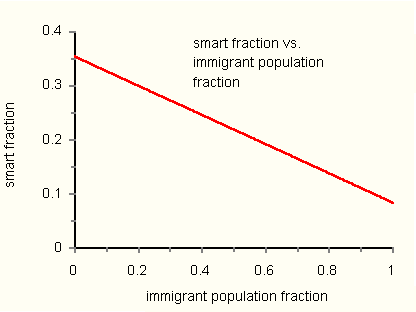
Figure 1. A country's smart fraction, and consequently its per capita GDP, declines linearly with the immigrant population
fraction, shown here for a native-immigrant cognitive gap of 1 SD.
"The Fourth Law: Consider a country with a third-world immigrant population fraction, f1. Suppose, because of
continued third-world net influx and/or fecundity differences, the population fraction increases to f2. We ask, what
percentage of the per capita GDP (at f1 ) will the per capita GDP be at f2? The answer is obtained from (3), using the
proportionality of per capita GDP and smart fraction:
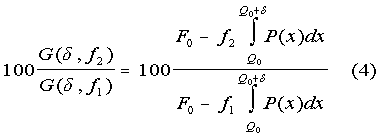
"An interesting special case occurs when
we start with no third worlders, i.e., f1 = 0.
That is, we ask what percentage of its
zero-immigrant value is the per capita
GDP when the population fraction is f.
This is obtained from (4) by setting f1 = 0,
and f2 = f:

"The per capita GDP as a percentage of its zero immigrant value is plotted in Figure 2, for
δ = 1.
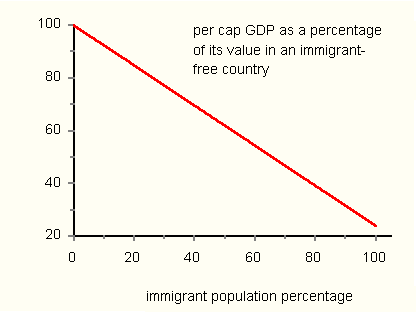
Figure 2. Per capita GDP as a percentage of its zero-immigrant value, shown here for a cognitive gap of 1 SD.
"The slope of the line in Figure 2 is -0.7604, which gives us the Fourth Law. That is, each percentage point increase in the
third-world immigrant population, will eventually cause the per capita GDP of a Western nation to drop by approximately
0.76 percent of its zero-immigrant value.
"As the third-world component of a Western nation builds, per capita GDP begins to drop.
Ultimately, the Western nation
will itself become part of the third world. Equation (5) traces its path to le tiers monde."
I was pleased at how smoothly my thoughts were flowing when Mentor interrupted. "How can we test your ideas?" he
queried.
Mentor's question was of course entirely appropriate. My results needed to be put to
a test. But how? Ideally, I would
want GDP data from a Western country with a large non-Western population fraction around long enough to reach some
sort of economic equilibrium. No European nation fit the bill. In Europe, the Netherlands
has the greatest proportion of non-Westerners, but even there, third worlders make up only 9% of the
population, not enough to shrink its per capita
GDP below the normal spread of values expected in comparable countries.
"There isn't a European country with a large enough third-world population to make a decent test," I remarked dejectedly."
"There is a solution, however," interjected Mentor, "and you will not need a gravity-wave
detector to implement it. Though no European
country has a large enough third-world population to run a valid test, there is a European-like nation that
suits your
needs. Can you guess what I have in mind? It is a country with a Western economic tradition, but burdened with a huge
third-world population that severely depresses its smart fraction and its per capita GDP."
I understood immediately. "You mean South Africa," I said excitedly. "May I borrow your CIA World Factbook?"
Mentor handed me the 2004 edition from which I noted that 16.2% of the South African population is
either white or Indian, the
rest being of the third world. "If we apply the Fourth Law to South Africa using a third-world population fraction of 0.838,
we predict that South Africa's per capita GDP has been depressed by its third-world population to approximately 36.3% of
its hypothetical 'pure European' value. If we now scale up South Africa's per
capita GDP of $10.7k (purchasing power parity basis) to its
hypothetical 'pure European' value, we get $29.5k, a value about in the middle
of the West European
countries, e.g., Finland $27.4k, France $27.6k, Norway $37.8k, Denmark
$31.1k, Belgium $29.1k, UK $27.7k, Switzerland $32.7k, Germany $27.6k, Austria
$30.0k, Netherlands $28.6k and Italy $26.7k."
I could not hide my delight. Mentor was pleased too. Sitting down at the piano, he broke into
song.
Hurrah for the flag of the free!
May it wave as our standard forever,
The gem of the land and the sea,
The banner of the right.
Let despots remember the day
When our fathers with mighty endeavor
Proclaimed as they marched to the fray
That by their might and by their right
It waves forever.
Mentor was playing a little game with me. I knew him well enough to know this was no random selection. "Look here," he said, pulling from his desk a recent
population projection by US Census Bureau demographers, "what can your Laws of Immigration tell us about the changing
face of America?"
Mentor handed me US population breakdowns by race and ethnicity estimated by the Census Bureau through mid-century.
Table 1 summarizes the estimates.
| Table 1. Evolution of First and Third World Populations in the US through 2050 |
|
|
Percent of Total
Population |
|
2000 |
2004 |
2010 |
2020 |
2030 |
2040 |
2050 |
| White not
Hispanic |
69.4 |
67.6 |
65.1 |
61.3 |
57.5 |
53.7 |
50.1 |
| Asian Alone |
3.8 |
4.1 |
4.6 |
5.4 |
6.2 |
7.1 |
8.0 |
| First World |
73.2 |
71.7 |
69.7 |
66.7 |
63.7 |
60.8 |
58.1 |
|
|
|
|
|
|
|
|
| Black alone |
12.7 |
12.8 |
13.1 |
13.5 |
13.9 |
14.3 |
14.6 |
| Hispanic (white) |
11.6 |
12.8 |
14.2 |
16.3 |
18.3 |
20.2 |
22.0 |
| All other races* |
2.5 |
2.7 |
3.0 |
3.5 |
4.1 |
4.7 |
5.3 |
| Third World |
26.8 |
28.3 |
30.3 |
33.3 |
36.3 |
39.2 |
41.9 |
|
| *Includes American Indian and Alaska Native alone, Native Hawaiian and Other Pacific Islander alone, and Two or More Races |
Figure 3 shows the trends graphically.
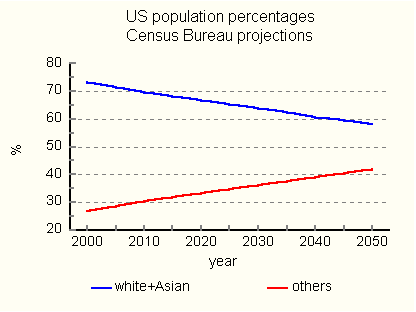
Figure 3. US Census Bureau projections of first and third world populations through mid-century.
Using values for f1 and f2 of 0.283 and 0.419, respectively, in (4), we expect that:
1) By 2050 the US per capita GDP will have declined, because of third-world immigration, to 86.8% of its 2004
value.
2) Correspondingly, from the Second Law, during this time the US mean IQ will have dropped by about 2 IQ
points.
I presented the results to Mentor. He seemed pleased. There would be plenty of time to institute a rational immigration
policy. Fifo would boost his class standing, and Mentor would boost his standing with Fifo's mom. On the way
home, Mentor's kitchen, redolent of garlic, was fresh upon my memory. I worked out a
simplification for my less
numerate fans so they too could share the joys of numerical immigration. I e-mailed
it to Mentor when I arrived home. It
is included
as an appendix to this account.
###
APPENDIX. A SIMPLE APPROXIMATION TO THE SMART FRACTION FOR PRODIGY'S
LESS NUMERATE READERS.
Write (3) as follows:

where

Expand g about δ = 1. To the quadratic term we have

With derivatives evaluated from (7), dropping the cubic and higher terms gives a numerical approximation to the smart fraction:

Equation (9) has the advantage of being algebraic. It will allow Fifo and others to play immigration games
of their own choosing.
Because it may sometimes be convenient to write the smart
fraction, F, in terms of conventional IQ units, Q, I include
such an expression obtained by substituting (100 - Q)/15 for δ
in (9):

The first term in both (9) and (10) is F0, the smart fraction in a European country with no third-world immigrants.
Because the expansions (9) and (10) have been truncated,
we need a sense of their accuracy. Figure 4 shows
the errors to
be negligible.
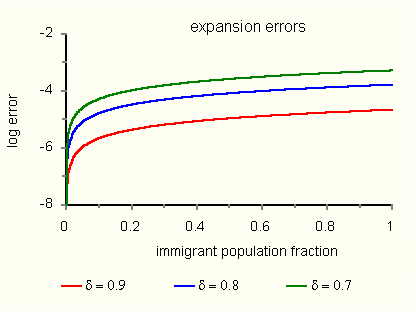
Figure 4. The difference between
accurate values of the smart fraction and the approximate smart fraction calculations of (9) or (10), stays well below 0.001 for
various choices of first- and third-world mean IQ differences.
###

